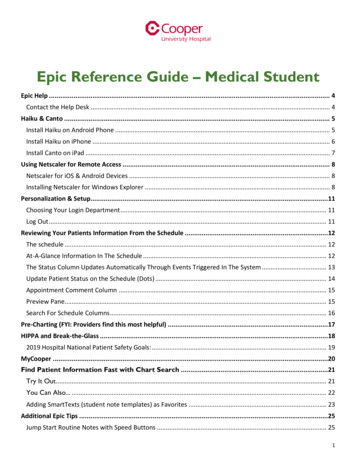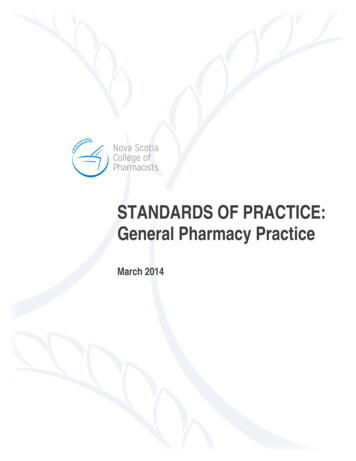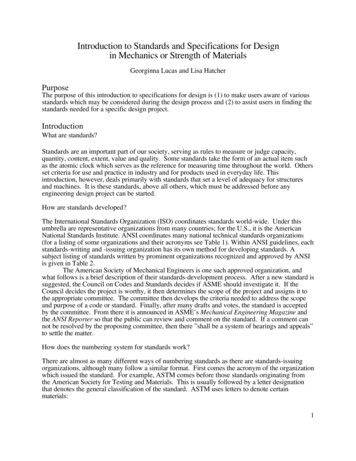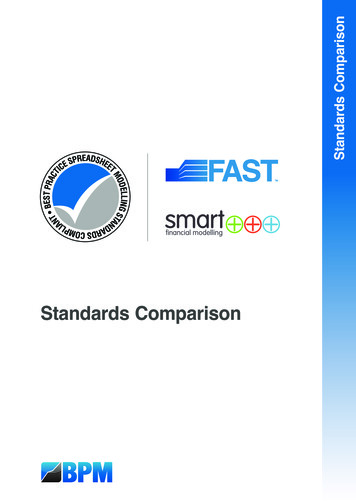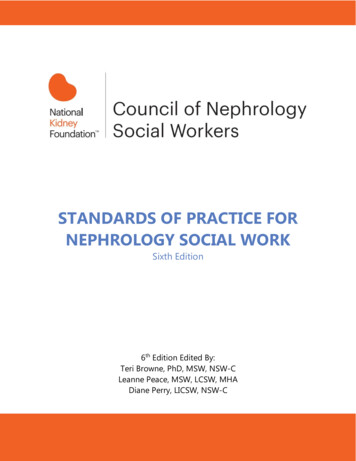
Transcription
STANDARDS OF PRACTICE FORNEPHROLOGY SOCIAL WORKSixth Edition6th Edition Edited By:Teri Browne, PhD, MSW, NSW-CLeanne Peace, MSW, LCSW, MHADiane Perry, LICSW, NSW-C
All rights reserved. No part of this may be reproduced without express written permission from theNational Kidney Foundation, Inc.Copyright 2014 National Kidney Foundation, Inc.All Rights Reserved.No part of this publication may be reproduced or transmitted in any form or by any means, electronic ormechanical, including photocopy, recording, or any information storage retrieval system, withoutpermission in writing from the National Kidney Foundation, Inc.National Kidney Foundation, Inc.30 East 33rd StreetNew York, NY 10016800-622-9010www.kidney.org
Council of Nephrology Social Workers30 E. 33rd StreetNew York, NY 10016Tel 212.889.2210Fax 212.689.9261www.kidney.org2014-2015 NKF-CNSWEXECUTIVE COMMITTEEDear Colleagues,CHAIROn behalf of the National Kidney Foundation’s Council of NephrologySocial Workers (CNSW), we would like to introduce the sixth edition of theStandards of Practice for Nephrology Social Work. In addition toupdating the material already in the book, it was also updated to includethe language of the new Conditions for Participation.Leanne Peace, MSW, LCSW, MHACHAIR-ELECTDebbie Brady, LCSW, ACSW, NSW-CIMMEDIATE PAST CHAIRStephanie J. Stewart, LICSW, MBAPROFESSIONAL EDUCATION CHAIRAndrea DeKam, LMSW, NSW-CMEMBERSHIP CHAIRJennifer Bruns, LMSW, CCTSWSCM15 Program ChairVernon Silva, LCSW, NSW-CSCM15 Program Co-ChairKim, Gusse, LMSW, ACSWPUBLICATION CHAIRCamille M. Yuscak, LCSW-R, NSW-CREGION I & V REPRESENTATIVELisa Hall, MSSW, LICSWREGION II & IV REPRESENTATIVELois Kelley, MSW, LSW, ACSW, NSW-CREGION III REPRESENTATIVEI wish to thank the editors of this edition, Teri Browne, PhD, MSW, NSW-C(CNSW Chair 2005-2009); Leanne Peace, MSW, LCSW, MHA (CNSW Chair2013-2015), and Diane Perry, LICSW, NSW-C (CNSW Region IIIRepresentative 2012-2014), and the rest of the CNSW Executive Committeewho took time to review this manual in great detail in the commitment tohave it as best as it can be for the CNSW membership.Nephrology social work continues to be an exciting and expanding field. Inaddition to dialysis and transplant social workers, we continue to seegrowth in other areas of practice such as pre-dialysis patient educators,social workers in management of dialysis companies, and research inuniversity settings. We hope this updated edition will continue to offerinformation and resources beyond just the clinical setting. CNSW hopesyou will find this a useful resource in your social work practice.Nikki Baune, MSW, LICSWSincerely,Stephanie Stewart, LICSW, MBACNSW Chair, 2011-2013
Council of Nephrology Social Workers Mission StatementThe Council of Nephrology Social Workers (CNSW) functions as a professionalmembership council within the framework of the National Kidney Foundation (NKF)and networks with other organizations, including the Centers of Medicare andMedicaid (CMS), state and local governments, and private groups. CNSW's purpose istwofold: one, to assist patients and their families in dealing with the psychosocialstresses and lifestyle readjustments and facilitate a treatment program that willmaximize rehabilitation potential; two, to support the federal regulations governingESRD reimbursement in regard to standards for social work practice and in thedefinition of a qualified social worker.Council of Nephrology Social Workers Strategic Goals Develop and promote patient and public education.Support and promote the profession and education of nephrology social work.Impact regulatory and legislative issues.Ensure the use of the qualified social work in the ESRD setting.Provide ongoing support and education to the kidney disease patient.
Table of Contents1. UNDERSTANDING CHRONIC KIDNEY DISEASENKF KIDNEY DISEASE OUTCOMES QUALITY INITIATIVE (NKF-KDOQI) Definition and Classification of CKDRole of the Nephrology Social Worker2. NEPHROLOGY SOCIAL WORKTHE ROLE OF THE NEPHROLOGY SOCIAL WORKER889101111ESRD REGULATIONS: DEFINITION OF SOCIAL SERVICES AND QUALIFIED SOCIAL WORKERS 12PRE-DIALYSIS EDUCATION: THE SOCIAL WORKER’S ROLE19TEAMWORK20ESRD FACILITY SURVEY21DOCUMENTATION FOR DIALYSIS SOCIAL WORKERS22QUALITY ASSESSMENT PERFORMANCE IMPROVEMENT (QAPI)25CNSW POSITION STATEMENT ON SOCIAL WORK STAFFING30APPROACH TO PATIENT/SOCIAL WORKER STAFFING37NEPHROLOGY SOCIAL WORK JOB DESCRIPTION44NEPHROLOGY SOCIAL WORK SUPERVISOR JOB DESCRIPTION46NEPHROLOGY SOCIAL WORK JOB PERFORMANCE APPRAISAL48NEPHROLOGY SOCIAL WORK CERTIFICATION50RECRUITMENT52RETENTION533. PSYCHOSOCIAL ASPECTS OF CHRONIC KIDNEY DISEASE56PSYCHOSOCIAL ASSESSMENT FORMSAdult Psychosocial Assessment ToolPediatric Psychosocial Assessment Tool565656KIDNEY TRANSPLANTATIONPsychosocial Considerations and EvaluationFinancial ConsiderationsRehabilitation and Vocational RehabRecommended Reading for Transplant Social Workers5859616262LIVING DONOR EVALUATION AND RESOURCES67INDEPENDENT LIVING DONOR ADVOCATE68REHABILITATION AND KIDNEY DISEASE & KIDNEY FAILUREBackgroundSelect Laws that Protect Workers with DisabilitiesSocial Security Disability ProgramsSocial Security Work Incentive Programs6969727374
Kidney-Specific Health Related Quality of Life (HRQoL) SurveysRehabilitation ResourcesFinancial AidJob Sharing77787980PALLATIVE CARE81PREGNANCY AND KIDNEY DISEASE85SUPPORT GROUPS86SYSTEM TARGETED INTERVENTION (STI)874. CHRONIC KIDNEY DISEASE MEDICAL INFORMATION88GLOSSARY OF MEDICAL TERMINOLOGY88Kt/V AND UREA REDUCTION RATIO (URR) DEFINITION95TREATMENT OPTIONSHemodialysisPeritoneal DialysisKidney Transplantation969698102NUTRITION1075. COUNCIL OF NEPHROLOGY SOCIAL WORKERS108HISTORY OF THE NKF-CNSWProfessional StandardsMembershipEmail hip108108109110110110111112112ORGANIZATIONAL CHART113CNSW RULES AND REGULATIONS115NKF, CNSW and CHAPTER RELATIONSHIPS120NKF ORGANIZATION1216. CHRONIC KIDNEY DISEASE INFORMATION122MEDICARE122ESRD NETWORKS126NATIONAL KIDNEY FOUNDATION129STATE RENAL PROGRAMS132AMERICAN KIDNEY FUND132AMERICAN ASSOCIATION OF KIDNEY PATIENTS133NATIONAL KIDNEY AND UROLOGIC DISEASE INFO CLEARINGHOUSE133
DIALYSIS PATIENT CITIZENS134THE WILLIAM B. DESSNER MEMORIAL FUND134SCHOLARSHIPS FOR KIDNEY PATIENTS134SUMMER CAMPS FOR DIALYSIS AND TRANSPLANT PATIENTS135RENAL SUPPORT NETWORK135LIFE OPTIONS136NATIONAL KIDNEY DISEASE EDUCATION PROGRAM (KDEP)136MEDICATION ASSISTANCE PROGRAMS136PEDIATRIC RESOURCES136TRANSIENT RESOURCES138TRANSPLANT RESOURCES1387. INTERNET RESOURCES FOR NEPHROLOGY SOCIAL WORKERS141APPENDIX A147APPENDIX B149
1. UNDERSTANDING CHRONIC KIDNEY DISEASENKF Kidney Disease Outcomes Quality Initiative (NKF KDOQI) In 1995, the National Kidney Foundation (NKF) began the development of what would become the firstbroadly accepted clinical practice guidelines in nephrology, now known as KDOQI—Kidney Disease OutcomesQuality Initiative. The first guidelines were published in 1997, and today there are 13 guidelines, which havemade a major difference in the quality of care for kidney patients in the United States and worldwide.With the publication of the Clinical Practice Guidelines and Clinical Practice Recommendations for Diabetesand Chronic Kidney Disease in February 2007, KDOQI achieved its primary goal of producing evidence-basedguidelines on the thirteen aspects of CKD care most likely to improve patient outcomes. We now seek toapply the knowledge acquired in the development and refinement of the KDOQI processes to improve clinicalpractice through a broader range of activities.All KDOQI Guidelines and Commentaries are published in the American Journal of KidneyDiseases (AJKD), NKF's premier journal, and can be accessed online at the NKF KDOQI website.GuidelinesThe National Kidney Foundation Kidney Disease Outcomes Quality Initiative (NKF KDOQI) hasprovided evidence-based clinical practice guidelines for all stages of chronic kidney disease (CKD)and related complications since 1997. Recognized throughout the world for improving thediagnosis and treatment of kidney disease, the KDOQI Guidelines have changed the practices ofnumerous specialties and disciplines and improved the lives of thousands of kidney patients.CommentariesKDOQI convenes a small work group of U.S. based experts to review the international guidelinesand write a commentary to help the U.S. audience understand the applicability and importance ofthe guidelines in their local clinical environment. These commentaries will form the basis for U.S.specific implementation tools and programs, which will be produced under the KDOQI brand.In 2009, Kidney Disease: Improving Global Outcomes (KDIGO) convened a controversies conference in 2009and then organized an international work group to review and update the 2002 NKF-KDOQI CKD guideline.After the international KDIGO guideline was published in 2013, NKF-KDOQI organized its own work group toprovide the KDOQI US Commentary on the 2012 KDIGO Clinical Practice Guideline for the Evaluationand Management of CKD.The NKF also offers a free Speaker's Guide, which explains the KDIGO 2012 Clinical Practice Guideline forCKD in simple, practical diction; helps you educate large or small groups of professional learners; and can alsobe viewed by individual clinicians for self-learning. Slides are available in English, Spanish, French andGerman.Standards of Practice for Nephrology Social Workers (6th Ed.)8
Understanding Chronic Kidney DiseaseDefinition and Classification of CKDCKD is defined as abnormalities of kidney structure or function, present for 3 months, with implications forhealth. KDIGO proposes classification of CKD by Cause, GFR and Albuminuria, respectively referred to asCGA staging. It can be used to inform the need for specialist referral, general medical management, andindications for investigation and therapeutic interventions. It will also be a tool for the study on theepidemiology, natural history, and prognosis of CKD.Albuminuria categoriesDescription and rangeCKD is classified based on: Cause (C) GFR (G) Albuminuria (A)GFR categories (ml/min/1.73 m2Description and rangeKDIGO 2012A1A2A3Normal to d 30 mg/g 3 mg/mmol30-299 mg/g3-29 mg/mmol 300 mg/g 30 mg/mmolG1Normal or high 90Monitor1Monitor1Refer*2G2Mildly decreased60-90Monitor1Monitor1Refer*2G3aMildly to oderately toseverely decreased30-44Monitor2Monitor3Refer3G4Severely decreased15-29Refer*3Refer*3Refer4 G5Kidney failure 15Refer4 Refer4 Refer4 Adapted with permission from KDIGO 2012 Clinical Practice Guideline for the Evaluation and Management of ChronicKidney Disease. Kidney Int. 2013;Suppl.3:1-150.Key to Figure:Colors: Represents the risk for progression, morbidity and mortality by color from best to worst.Green: low risk (if no other markers of kidney disease, no CKD); Yellow: moderately increased risk;Orange: high risk; Red, very high risk.Numbers: Represent a recommendation for the number of times per year the patient should bemonitored.Refer: Indicates that nephrology referral and services are recommended.*Referring clinicians may wish to discuss with their nephrology service depending on localarrangements regarding monitoring or referral.Standards of Practice for Nephrology Social Workers (6th Ed.)9
Understanding Chronic Kidney DiseaseRole of the Nephrology Social Worker in KDOQI and KDIGOThe nephrology social worker plays an important role in helping the patient meet the outcomes as outlined inthe K/DOQI & KDIGO guidelines. Through a focused assessment, the social worker can identify thepsychosocial issues that are a barrier to achieving optimal treatment outcomes and can implement clinicalinterventions to reduce these barriers. Patient education, advocacy, cognitive and behavioral interventions,quality of life measurements and resource referrals as well as other interventions can be used by the socialworker to resolve barriers.The Comprehensive Interdisciplinary Assessment Document (CIPA) was developed by CNSW in 2008 toassist social workers in the assessment of barriers that have an impact on treatment outcomes. It coversbarriers related to obtaining hemodialysis and peritoneal adequacy, attaining vascular access guidelines,meeting anemia management guidelines, attaining nutritional guidelines, and addressing adherence issuessuch as understanding emotional/behavioral processes, resources and problems during treatment.Standards of Practice for Nephrology Social Workers (6th Ed.)10
2. NEPHROLOGY SOCIAL WORKTHE ROLE OF THE NEPHROLOGY SOCIAL WORKERNephrology social work services support and maximize the psychosocial functioning and adjustment ofchronic kidney disease patients and their families. These services are provided to improve social andemotional stresses resulting from the interacting physical, social, and psychological concomitants ofchronic kidney disease which include shortened life expectancy, altered lifestyle with changes in social,financial, vocational, and sexual functioning, and the demands of a rigorous, time-consuming, andcomplex treatment regimen.The nephrology social worker is a part of an interdisciplinary team and provides collaboration with otherteam members to help them in understanding the biopsychosocial factors that can impact treatmentoutcome. The major interventions provided by nephrology social workers include: Pre-dialysis education and assessment Ongoing Biopsychosocial Assessment (including quality of life measurement) Casework (counseling and conferences with patients, families, and support networks; crisisintervention goal-directed counseling; discharge planning) Group work (education, emotional support, self-help) Mediation Information and Referral Facilitation of community agency referrals Interdisciplinary care planning and collaboration Advocacy on patients’ behalf within the setting and with appropriate local, state and federalagencies and programs Patient and family educationThe major categories of problems addressed by nephrology social workers include: Adjustment to chronic illness and treatment as they relate to the patient’s quality of life Physical, sexual, and emotional relationship problems Educational, vocational, and activity of daily living problems Conflict resolution Problems related to treatment options and setting transfers Resource needs, including finances, living arrangements, and transportation Decision making with regard to advance directivesThe nephrology social worker and management must work together in establishing mutually agreed-upongoals and responsibilities. Many tools are available through the National Kidney Foundation’s Council ofNephrology Social Workers to assist in this process; see, for example, Comprehensive InterdisciplinaryAssessment Document (CIPA).Adapted from the “NASW/NKF Clinical Indicators for Social Work and Psychosocial Services in Nephrology Settings,” (1994) Washington, DC: NASW Press.Standards of Practice for Nephrology Social Workers (6th Ed.)11
Nephrology Social WorkESRD REGULATIONS: DEFINITION OF SOCIAL SERVICES ANDQUALIFIED SOCIAL WORKERSPosition Paper of the NKF Council of Nephrology Social WorkersPosition:The Council of Nephrology Social Workers of the National Kidney Foundation,representing over 700 nephrology social workers in dialysis and transplantfacilities, strongly supports enforcement of the current federal regulationsgoverning ESRD reimbursement regarding standards for Social Services andthe definition of a qualified social worker.Historical Overview: The Changing Patient PopulationAs part of the Social Security Amendment of 1972, Congress extended Medicare coverage to personsdiagnosed with ESRD. The following summer, on July 1, 1973, enrollment of ESRD patients began (FederalRegister, 1976). At that time, only about 11,000 patients were receiving chronic dialysis treatments, and itwas believed that the extension of Medicare coverage would help to save those lives, as well as the livesof future patients, while reducing the financial burden of their illness. When the regulations were firstissued, it would have been difficult to predict the numbers of future patients who would be stricken withESRD and the often overwhelming medical, social, and psychological problems these patients wouldconfront. In 2010, there were 116,946 new patients diagnosed with ESRD, and 594,374 total prevalentpatients with ESRD in the U.S. It is projected that by 2030 the number of ESRD patients will increase to2.24 million (U.S. Renal Data System, 2012).In addition to the ESRD population growing in numbers, information from the U.S. Renal Data System(USRDS) indicates that patients are also growing older. In 1977, the median age of new ESRD patients was54 with 27% over age 65. In 2008, the median age had risen with 36% of the population over age 65(USRDS, 2010). The rates of elderly patients, age 75 and older, have doubled since 1997 (USRDS). Theaging process alone often leads to other more complex medical and psychosocial dilemmas. For example,elderly individuals are often faced with declining physical and emotional capabilities, loss of emotionaland social support systems, shrinking income, increasing health problems, increasing occurrence ofdementia, as well as housing and transportation difficulties.While increasing numbers and the aging process present potentially serious problems in the ESRDpopulation, other growing problems also exist. One problem is the increasing prevalence of other diseaseentities. According to the USRDS, the incidence of diabetes and hypertension in ESRD patients is morethan 50% above average (1989). Another patient group whose numbers are growing are those infectedwith AIDS. For at least three years (1985-1987), the annual Health Care Financing Administration (HCFA;now Centers for Medicare & Medicaid Services, or CMS) survey of dialysis facilities reported an annualincrease in the number of patients infected with the AIDS virus. While true incidence and prevalence dataare not available for the ESRD population, the Centers for Disease Control and Prevention (CDC) estimates(based on the incidence of AIDS in the general population) that 10,000 to 15,000 persons will developStandards of Practice for Nephrology Social Workers (6th Ed.)12
Nephrology Social Workrenal disease in association with AIDS (Schoenfeld & Feduska, 1990). Mortality rates are also higher in theESRD population than in the general population. The life expectancy of ESRD patients is 75% lower thansimilar individuals without ESRD (Moss, 2005).Some of the other serious psychosocial issues which arise in the ESRD population are cited in the 1989USRDS report:Kidney failure is a devastating medical, social and economic problem to the patient andhis or her family. The initial experience may leave the patient feeling vulnerable,dependent, and at death's door. After replacement therapy is initiated, the otherproblems become more prominent. Social adjustment to the dependency, the reducedquality of life, the low likelihood of returning to work, genuine higher mortality rates,and the dramatically lowered economic standard are all part of the problems. If thepatient was not poor before kidney failure, it is very likely that he/she will be after.In addition to issues cited above are the demands of a rigorous time-consuming treatment regimen; thefinancial disincentives to successful vocational rehabilitation (i.e., losing disability payments, etc.);diminishing community resources; as well as a whole range of psychosocial responses to illness andtreatment, including anger, frustration, anxiety, and depression. Addressing these psychosocial stressesand the lifestyle readjustment demanded of patients and their families is an essential part of thetherapeutic process in order to facilitate the effective use of a costly treatment program and to maximizetreatment potential.Review of Current ESRD Regulations: Definition of Social ServicesAlmost four decades ago when regulations governing ESRD settings and professionals serving in thesesettings were being formulated, general knowledge of the relatively new field of ESRD treatment waslimited among policy makers and professionals alike. Even less was understood about how increasinglycomplex individuals' lives would become medically, socially, and psychologically as a result of thediagnosis and treatment of ESRD. The federal government, as early as 1976, acknowledged that theultimate goal of ESRD treatment is to not only extend life but to extend meaningful and productive life. Tothat end, the Centers for Medicare and Medicaid (CMS) regulations governing reimbursement for dialysisand transplantation were written mandating that social work services be an integral part of patient care.The Standard for Social Services, effective September 1, 1976, was specified in the Final Regulations405.2163 (b) (Federal Register, 1976):Social Services are provided to patients and their families and are directed at supportingand maximizing the social functioning and adjustment of the patient. Social Services arefurnished by a qualified social worker who has an employment or contractual relationshipwith the facility. The qualified social worker is responsible for conducting psychosocialevaluations, participating in team review of patient progress and recommending changesin treatment based on the patient's current psychosocial needs, providing casework andgroup work services to patients and their families in dealing with the special problemsassociated with ESRD, and identifying community social agencies and other resources andassisting patients and families to utilize them.By 2008, the CMS Conditions for Coverage for ESRD Facilities (CfCs) were revised for both the dialysis andtransplant settings (Federal Register, 2007, 2008). The conditions both mandated an emphasis on theimportance of attending to psychosocial barriers to kidney disease. CNSW compiled a chart for itsStandards of Practice for Nephrology Social Workers (6th Ed.)13
Nephrology Social Workmembers, which outlines all aspects of the 2008 CfCs for the dialysis setting that attend to psychosocialaspects of ESRD. This chart includes the actual language in the document, as well as the language fromthe document’s preamble. The chart is available HERE.ESRD Regulations: Definition of a Qualified Social WorkerIn describing the Social Services which are required in the ESRD setting, a qualified social worker must beavailable to provide such services in order for a facility to bill Medicare for services. The 2008 ESRDregulations for dialysis units define a qualified social worker as(Federal Register, 2008, §494.140(d)(1)):The facility must have a social worker who—(1) Holds a master’s degree in social work with a specialization in clinical practice froma school of social work accredited by the Council on Social Work Education; or(2) Has served at least 2 years as a social worker, 1 year of which was in a dialysis unitor transplantation program prior to September 1, 1976, and has established aconsultative relationship with a social worker who qualifies under §494.140(d)(1).The 2008 dialysis ESRD regulations also mandate (Federal Register, 2008, § 494.180):All dialysis facility staff must meet the applicable scope of practice board and licensurerequirements in effect in the State in which they are employed. The dialysis facility’s staff(employee or contractor) must meet the personnel qualifications and demonstratedcompetencies necessary to serve collectively the comprehensive needs of the patients. Thedialysis facility’s staff must have the ability to demonstrate and sustain the skills neededto perform the specific duties of their positions.Furthermore, the 2008 ESRD dialysis regulations mandate (Federal Register, 2008, § 494.140):The governing body or designated person responsible must ensure that—(1) An adequate number of qualified personnel are present whenever patients areundergoing dialysis so that the patient/staff ratio is appropriate to the level ofdialysis care given and meets the needs of patients; and the registered nurse, socialworker and dietitian members of the interdisciplinary team are available to meetpatient clinical needs;(2) All employees have an opportunity for continuing education and relateddevelopment activities.The 2008 regulations replaced the 1976 ESRD regulations for dialysis centers, that defined a qualifiedsocial worker in a dialysis unit as (Federal Register, 2008, § 405.2102(r)(6):A person who is licensed, if applicable, by the State in which practicing, and:Standards of Practice for Nephrology Social Workers (6th Ed.)14
Nephrology Social Work(i)Has completed a course of study with specialization in clinical practice at, andholds a master's degree from a graduate school of social work accredited bythe Council on Social Work Education; or(ii)Has served for at least 2 years as a social worker, 1 year of which was in adialysis unit or transplantation program prior to effective date of theseregulations, and has established a consultative relationship with a socialworker who qualifies under item (6) (i) of this section.The 2007 ESRD regulations for kidney transplant centers define a qualified social worker as (FederalRegister, 2007, § 482.94(3)(ii)(d)) as:A qualified social worker is an individual who meets licensing requirements in the State inwhich he or she practices; and(1) Completed a course of study with specialization in clinical practice and holds amaster’s degree from a graduate school of social work accredited by the Council onSocial Work Education; or(2) Is working as a social worker in a transplant center as of the effective date of thisfinal rule and has served for at least 2 years as a social worker, 1 year of which wasin a transplantation program, and has established a consultative relationship witha social worker who is qualified under (d)(1) of this paragraph.The knowledge base and skills required by a nephrology social worker in order to effectively evaluate andtreat ESRD patients and families are multi-faceted. Areas of knowledge include an understanding ofindividual behavior, family dynamics and the environmental context within which the patient/familyinteract; the psychosocial impact of chronic illness and treatment on patient/family functioning; treatmentteam interaction and communication patterns; and the existence and utilization of family and communityresources. Social work skills required include interviewing and assessment; treatment expertise inindividual, family, and group counseling; identifying, using and/or developing needed communityresources, including those which can facilitate successful social and vocational rehabilitation; and effectivecommunication with and participation in team review of patient care. Increasingly, the nephrology socialworker must have the ability to assess the appropriateness of a patient and family's home care plans. Thissocial work assessment is essential in helping to formulate treatment plans which can ultimately decreasethe cost of both prolonged hospitalizations and nursing home placements. Finally, the nephrology socialworker frequently serves as an advocate for patients and families, assisting them to work within systemswhich may be overwhelming and extremely confusing.The Qualified ESRD Social Worker: Educational PreparationThe mandate from the federal government to provide patients with access to qualified social workservices is even more critical today than when the regulations were first enacted more than 35 years ago.The complexity and increasing severity and multiplicity of problems of ESRD patients requires highlydeveloped and sophisticated social work skills.A study conducted by CNSW in 1988 clearly illustrates this point. The study was conducted because ofconcerns about the quality and accessibility of social work services provided in dialysis facilities.Standards of Practice for Nephrology Social Workers (6th Ed.)15
Nephrology Social WorkResponses from 345 social workers representing approximately 25,000 ESRD patients were obtained. Acomparison with 1987 HCFA data indicated that responses were representative of the types of facilities inoperation (CNSW, 1988).From the data obtained, information was gathered on caseload and types of problems the ESRD socialworker encounters. A full-time social worker (FT 32-40 hrs. weekly) carried an average caseload of 102patients. In this "average" caseload of 102, 20 patients are diabetic, 3 live in nursing homes, 3 are sodebilitated that they require ambulance transportation to treatment, 3 have general transportationproblems, 10 patients have inadequate support systems, 17 need financial assistance to pay formedications, and 27 receive Medicaid benefits and are financially indigent. All of these situations canpresent serious problems for patients and would require the intervention of a skilled social worker.Almost twenty-five years later, CNSW determined that caseloads remain high for dialysis and kidneytransplant social workers in national surveys of thousands of social workers (Merighi, Browne, & Bruder,2010). To view poster, visit Appendix A (p. 147).Between 2007 and 2010, outpatient dialysis social workers experienced increases in mean caseload sizefrom 73 to 79 (up 8.2%) for those employed 20–31 hours per week, 113 to 121 (up 7.1%) for thoseemployed 32–40 hrs/wk, and 117 to 126 (up 7.7%) for those employed 40 hrs/wk. To read more, visit thearticle by Merighi, Browne, and Bruder in the Journal of Nephrology Social Work (JNSW), Volume 34,Winter 2010.Each of the problems cited above are serious and require highly-skilled social work intervention.Educational preparation as outlined by the Council on Social Work Education (CSWE) clearly calls for amaster's-prepared social worker to assess and intervene in these problem areas. The CSWE defines theBSW, or baccalaureat
On behalf of the National Kidney Foundation’s Council of Nephrology Social Workers (CNSW), we would like to introduce the sixth edition of the Standards of Practice for Nephrology Social Work. In addition to updating the material already in the book, it was also updated to incl



